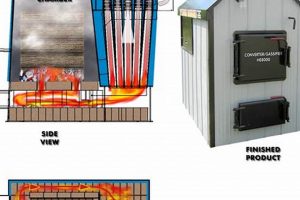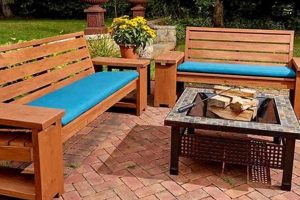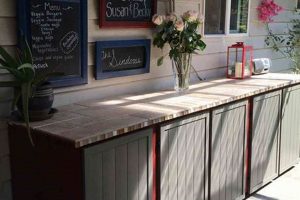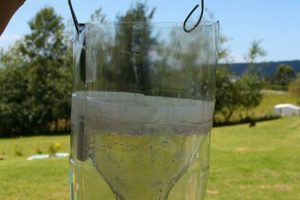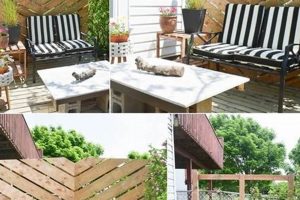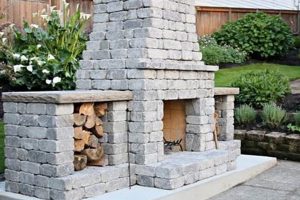A self-constructed piece of furniture designed for exterior use, specifically for seating multiple individuals, offers a customizable and often cost-effective alternative to purchasing manufactured outdoor furniture. These projects frequently utilize readily available materials such as repurposed pallets, lumber, and concrete blocks, allowing for a broad range of aesthetic styles and sizes. A simple example would be a frame built from pressure-treated wood topped with cushions made from weather-resistant fabric.
Constructing seating arrangements for exterior spaces presents multiple advantages. Individuals can tailor the dimensions and design to perfectly fit their specific outdoor area and personal preferences. This method can also be more economical than purchasing pre-made furniture, especially when utilizing reclaimed or recycled materials. Historically, the practice of building one’s own furniture demonstrates resourcefulness and adaptability, fulfilling a need for functional items using available local resources. It also promotes creativity and a sense of accomplishment.
The following sections will detail various design considerations, material selection guidelines, and step-by-step building instructions to facilitate the successful creation of personalized outdoor seating solutions.
Essential Considerations for Constructing Outdoor Seating
The following recommendations aim to enhance the durability, comfort, and aesthetic appeal of self-built outdoor seating projects. Adhering to these guidelines can prolong the lifespan of the structure and maximize user satisfaction.
Tip 1: Material Selection is Paramount: Utilize pressure-treated lumber or naturally weather-resistant wood types like cedar, redwood, or teak. This minimizes decay and insect infestation. Untreated wood requires regular sealing and is less suitable for prolonged outdoor exposure.
Tip 2: Prioritize Weather-Resistant Fasteners: Employ stainless steel or exterior-grade screws and bolts. Standard fasteners will corrode over time, weakening the structural integrity of the seating.
Tip 3: Accurate Measurements and Planning are Crucial: Develop a detailed plan with precise dimensions before commencing construction. This reduces material waste and ensures a structurally sound and aesthetically pleasing outcome.
Tip 4: Ensure Proper Drainage: Design the seating to allow for adequate water runoff. Incorporate slight angles on surfaces and utilize breathable cushion fabrics to prevent moisture accumulation, which can lead to mold and mildew growth.
Tip 5: Cushion Fabric Choice Matters: Opt for fabrics specifically designed for outdoor use, such as Sunbrella or similar brands. These fabrics are UV-resistant, water-repellent, and resistant to fading. Consider using a water-resistant liner to further protect the cushion filling.
Tip 6: Regular Maintenance is Essential: Periodically clean the seating with a mild soap and water solution. Reapply sealant or stain as needed to maintain the protective coating on the wood. Store cushions indoors during inclement weather to prolong their lifespan.
Tip 7: Comfort is Key: Carefully select cushion thickness and density for optimal comfort. Consider ergonomic design principles to provide adequate back support and legroom.
Implementing these considerations will result in a durable, comfortable, and visually appealing seating solution for outdoor spaces.
The subsequent sections will delve into specific design examples and advanced construction techniques.
1. Material Weather Resistance
Material weather resistance forms a foundational component of any durable, self-constructed outdoor seating arrangement. Exposure to the elements, including rain, sunlight, temperature fluctuations, and humidity, exerts constant stress on the materials employed. Inadequate resistance to these factors leads to premature degradation, structural weakening, and ultimately, the failure of the furniture. Consequently, the careful selection of weather-resistant materials is not merely an aesthetic consideration but a critical determinant of the longevity and safety of the final product. For instance, untreated softwood exposed to consistent moisture will exhibit rot and decay, rendering it structurally unsound within a relatively short period. Conversely, pressure-treated lumber or naturally resistant hardwoods like cedar or teak offer superior protection against these detrimental effects.
The choice extends beyond the wood itself. Fasteners, finishes, and fabrics must also exhibit appropriate weather resistance. Standard steel screws are prone to corrosion, weakening joints and potentially causing staining on the surrounding wood. Stainless steel or coated alternatives mitigate this risk. Likewise, cushions and upholstery should be crafted from materials specifically designed for outdoor use. These fabrics typically incorporate UV inhibitors to prevent fading and are treated with water-repellent coatings to minimize moisture absorption. Neglecting these considerations can lead to unsightly discoloration, mildew growth, and a significantly shortened lifespan for the seating.
In summation, material weather resistance constitutes a non-negotiable aspect of building seating for exterior use. The initial investment in appropriate materials translates directly into long-term durability, reduced maintenance costs, and a safer, more enjoyable outdoor living space. Understanding the specific environmental challenges posed by a given location is crucial for making informed material choices and ensuring the enduring performance of the finished product. The potential challenges, such as higher initial costs for weather-resistant materials, are offset by the extended lifespan and reduced maintenance demands of a properly constructed project.
2. Structural Integrity
Structural integrity, in the context of constructing a self-made outdoor seating arrangement, directly correlates with the safety and longevity of the finished product. It denotes the ability of the structure to withstand applied loads and environmental stresses without deformation or failure. Weak structural integrity poses immediate risks, including collapse under normal use, leading to potential injury. The choice of materials, construction techniques, and joinery methods all influence the structural soundness of the piece. For instance, using insufficient support beams or improperly fastened joints can create weak points vulnerable to breakage under weight or stress from wind or other external forces. Real-world examples include seating made from repurposed pallets where internal supports are either absent or deteriorated, causing the structure to buckle or collapse.
Achieving adequate structural integrity necessitates careful planning and execution. Selecting lumber of appropriate dimensions, employing robust joinery techniques such as mortise and tenon or reinforced screw connections, and incorporating diagonal bracing to resist racking forces are critical steps. Furthermore, considering the anticipated weight load and environmental conditions is paramount. Seating intended for frequent use by multiple individuals requires a more substantial framework than seating designed for occasional single-person use. Similarly, structures located in areas prone to high winds or heavy snowfall must be engineered to withstand those specific stresses. A practical application involves thoroughly assessing the weight-bearing capacity of each component and reinforcing any areas deemed potentially weak.
In summary, structural integrity is an indispensable characteristic of any outdoor seating project. Compromises in this area jeopardize user safety and significantly shorten the lifespan of the furniture. Prioritizing sound construction practices, selecting appropriate materials, and carefully assessing load-bearing requirements are essential for creating a durable and reliable outdoor seating solution. The long-term benefits of a structurally sound design far outweigh the initial investment in time and resources, resulting in a safer and more enjoyable outdoor experience.
3. Ergonomic Comfort
Ergonomic comfort represents a critical, often underestimated, component in the design and construction of seating for outdoor environments. Disregarding ergonomic principles in the creation of an “outdoor diy sofa” can lead to discomfort, strain, and ultimately, reduced usability. The correlation manifests as a direct cause-and-effect relationship: improperly dimensioned seating, lacking adequate back support or featuring excessively hard surfaces, inevitably results in a negative user experience. The importance of ergonomic design lies in its ability to transform a merely functional structure into a truly inviting and enjoyable space. For example, a well-built sofa with a seat height that forces users into an awkward posture will likely remain unused, regardless of its aesthetic appeal or construction quality.
Practical application of ergonomic principles involves careful consideration of several key factors. Seat height should facilitate easy ingress and egress, typically ranging from 16 to 18 inches. Seat depth must provide sufficient support for the thighs without restricting circulation behind the knees. Backrests should offer lumbar support, promoting proper spinal alignment and reducing strain on the lower back. Cushioning materials play a significant role, balancing support and pressure distribution. Hard surfaces can be softened with appropriately sized and shaped cushions constructed from resilient materials that conform to the body’s contours. The angle of the backrest should also be carefully considered, with a slight recline often preferred for relaxation. A real-world scenario highlighting this significance would be creating a seating arrangement that encourages socialization and relaxation during an outdoor gathering.
In summary, ergonomic comfort is not an optional add-on but an integral design element of a successful, hand-built seating arrangement for exterior settings. Prioritizing ergonomic considerations translates directly into enhanced user satisfaction, increased usage, and a more positive overall outdoor experience. Challenges may arise in balancing ergonomic design with aesthetic preferences or budget constraints, but these can be overcome through careful planning and creative problem-solving. By integrating ergonomic principles from the outset, builders can create seating that is not only visually appealing and structurally sound but also conducive to relaxation and well-being.
4. Design Customization
Design customization, in the context of a self-made seating solution intended for outdoor spaces, provides a significant advantage over mass-produced furniture. It allows the creator to tailor the seating arrangement to specific spatial constraints, aesthetic preferences, and functional requirements. This adaptability enhances the overall utility and integration of the furniture within its intended environment. The possibility for personalization differentiates a self-built project from generic alternatives, establishing its value.
- Dimensional Adaptation
Dimensional adaptation involves modifying the overall size and proportions of the seating to precisely fit the available outdoor space. This is particularly relevant for irregularly shaped patios, decks, or balconies where standard furniture dimensions may prove unsuitable. For instance, a long, narrow balcony may necessitate a custom-built bench rather than a bulky sofa. This adaptation ensures optimal space utilization and prevents the seating from overwhelming the area.
- Material Selection Variance
Material selection variance permits the use of specific materials based on budgetary constraints, aesthetic considerations, or environmental concerns. Reclaimed lumber, for example, offers a sustainable and cost-effective alternative to purchasing new materials. Furthermore, material selection can be tailored to match the existing architectural style of the outdoor space, creating a cohesive and harmonious aesthetic. If the surrounding patio consists of stone, incorporating similar stone accents into the seating design will achieve visual coherence.
- Functional Augmentation
Functional augmentation refers to the incorporation of features tailored to specific user needs. Integrated storage compartments for cushions or gardening tools, built-in side tables for drinks, or adaptable configurations for varying group sizes all exemplify functional augmentation. A user may require a seating arrangement that easily converts into a daybed for sunbathing or a modular configuration that can be rearranged for social gatherings. These functional enhancements increase the usability and value of the seating.
- Aesthetic Personalization
Aesthetic personalization involves modifying the visual characteristics of the seating to reflect personal style and preferences. This encompasses choices related to color, texture, and overall design aesthetic. Users can select specific paint colors, stain finishes, or fabric patterns to match their existing outdoor decor or create a unique focal point. Incorporating decorative elements such as mosaic tiles, carved details, or custom-designed cushions further enhances the aesthetic personalization of the seating.
These facets of design customization, when applied to the creation of a seating arrangement for outdoor spaces, empower individuals to construct furniture that precisely meets their needs and reflects their unique style. By adapting dimensions, selecting materials, augmenting functionality, and personalizing aesthetics, users can transform generic outdoor areas into personalized and functional living spaces. This level of control is unattainable with mass-produced furniture, highlighting the benefits of self-built solutions.
5. Cost Efficiency
The element of cost efficiency is a primary motivator for individuals considering the construction of their seating for outdoor areas. Constructing furniture, as opposed to purchasing pre-made alternatives, can significantly reduce expenses. The magnitude of these savings depends on factors such as material choices, design complexity, and the availability of existing tools and resources.
- Material Sourcing Strategies
Acquiring materials constitutes a substantial portion of the total project cost. Implementing strategic sourcing practices can mitigate these expenses. Repurposing reclaimed lumber from demolition sites, utilizing discarded pallets (with appropriate safety precautions and treatment), or purchasing discounted materials from local suppliers can significantly lower material costs compared to purchasing new lumber from retail outlets. However, one must consider the time investment in locating, acquiring, and preparing these materials.
- Labor Input Valuation
Self-construction eliminates labor costs typically associated with furniture manufacturing. The individual undertaking the project provides the labor, effectively valuing their time invested. This labor input translates directly into cost savings, particularly for complex designs that would command high prices if purchased pre-made. This is especially impactful for those with existing woodworking skills, but even for beginners, the cost savings can be substantial when factoring in the price of professional furniture assembly.
- Design Simplification Impact
Simplifying the design of the seating significantly reduces material requirements, construction time, and skill level needed, thereby reducing overall project costs. Complex joinery, intricate detailing, and unconventional shapes necessitate more materials, specialized tools, and advanced woodworking skills, increasing the financial investment. Opting for a straightforward design with basic joinery techniques, such as a simple frame with screwed connections, is more economical and accessible to novice builders.
- Tool Investment Considerations
While self-construction eliminates labor costs, it may necessitate the purchase or rental of tools. Individuals lacking basic woodworking tools, such as a saw, drill, and measuring instruments, must factor in the cost of acquiring these items. Purchasing used tools or borrowing from friends or family can reduce these expenses. However, neglecting to use the appropriate tools may result in a lower-quality finished product and potentially increase material waste, negating some of the initial cost savings.
Ultimately, the cost efficiency of constructing a piece of furniture depends on a confluence of factors. Careful planning, strategic material sourcing, design simplification, and responsible tool management contribute to maximizing cost savings. While not always the most economical choice in terms of time investment, self-construction offers a path to acquiring customized seating at a lower financial cost than purchasing comparable pre-made furniture, especially when leveraging readily available or repurposed materials. The benefits also extend to gaining skills and a sense of accomplishment.
6. Maintenance Requirements
Maintenance requirements represent a crucial, and often overlooked, aspect of constructing seating solutions intended for use in outdoor environments. Structures exposed to the elements necessitate routine care to preserve their structural integrity, aesthetic appeal, and overall longevity. The degree and frequency of maintenance vary depending on factors such as material selection, construction techniques, and prevailing environmental conditions.
- Material-Specific Upkeep
Different materials exhibit varying maintenance needs. Wood, for example, requires periodic sealing or staining to protect against moisture absorption, ultraviolet radiation, and insect infestation. Failure to maintain a protective coating can lead to rot, warping, and cracking. Metal components may require rust prevention measures, such as painting or the application of protective coatings. Fabric cushions necessitate regular cleaning to prevent the accumulation of dirt, mold, and mildew. Neglecting material-specific upkeep diminishes the lifespan and appearance of the seating.
- Fastener Inspection and Tightening
Exposure to the elements and repeated use can cause fasteners, such as screws and bolts, to loosen over time. Regular inspection and tightening of these fasteners is essential to maintain the structural integrity of the seating. Loose fasteners can compromise joint stability, leading to wobbling, creaking, and ultimately, structural failure. Employing corrosion-resistant fasteners, such as stainless steel, mitigates the risk of rust and further deterioration.
- Surface Cleaning Protocols
Routine cleaning of all surfaces is necessary to remove dirt, debris, and organic matter that can promote the growth of mold and mildew. The appropriate cleaning method depends on the material. Wood surfaces can be cleaned with a mild soap and water solution, while metal surfaces may require specialized cleaning agents to remove rust or oxidation. Fabric cushions should be cleaned according to the manufacturer’s instructions. Neglecting surface cleaning can result in unsightly staining, unpleasant odors, and accelerated material degradation.
- Protective Covering Implementation
The use of protective covers during periods of inclement weather or extended non-use can significantly reduce the maintenance burden and prolong the lifespan of seating. Covers shield the structure from rain, snow, and direct sunlight, minimizing the effects of weathering. Custom-fitted covers provide the most effective protection, preventing moisture accumulation and wind damage. While not eliminating the need for regular maintenance, protective covers reduce its frequency and intensity.
In summary, the long-term viability of seating intended for external use hinges on adherence to a consistent maintenance schedule. Neglecting these requirements leads to premature deterioration, increased repair costs, and a diminished aesthetic appeal. By understanding and addressing the specific maintenance needs of the materials and construction methods employed, individuals can ensure the continued enjoyment and functionality of their outdoor seating arrangement.
7. Aesthetic Integration
The concept of aesthetic integration represents a fundamental consideration in the design and construction of seating solutions for outdoor environments. Aesthetic integration, in this context, refers to the harmonious blending of the structure’s visual characteristics with the surrounding landscape, architectural elements, and overall ambiance. Neglecting this aspect during the creation of a self-built seating arrangement results in a visually discordant element that detracts from the aesthetic appeal of the outdoor space. The effect of a poorly integrated seating arrangement can range from a minor visual distraction to a complete disruption of the intended atmosphere. As a real-life example, a modern, minimalist seating arrangement constructed from stark metal and angular lines would appear incongruous when placed within a traditional garden setting characterized by soft curves, natural stone pathways, and lush vegetation. This visual disharmony undermines the intended purpose of the outdoor space as a relaxing and visually appealing environment.
Achieving aesthetic integration necessitates careful consideration of various design factors. The selection of materials, colors, and forms should complement the existing landscape and architectural elements. Natural materials, such as wood and stone, often blend seamlessly with outdoor environments, while synthetic materials may require careful selection to avoid appearing artificial or out of place. Color palettes should be chosen to harmonize with the surrounding flora and existing structures. Earth tones, muted hues, and natural shades tend to integrate more effectively than bright, contrasting colors. The overall form of the seating should also align with the prevailing design aesthetic. Smooth, flowing lines complement organic landscapes, while geometric shapes harmonize with modern architectural styles. Furthermore, the scale of the seating must be proportionate to the size of the outdoor space to avoid overwhelming or understating its presence. Smaller spaces necessitate more delicate and understated designs, while larger areas can accommodate more substantial and visually imposing structures. Incorporating elements from the surrounding environment, such as using local stone or incorporating native plants into the design, can further enhance the aesthetic integration of the seating.
In conclusion, aesthetic integration constitutes an indispensable element in the creation of visually pleasing and functional outdoor seating arrangements. Neglecting this aspect compromises the overall aesthetic appeal of the outdoor space, while prioritizing harmonious blending enhances its visual coherence and creates a more inviting and enjoyable environment. Challenges may arise in balancing personal preferences with the need for aesthetic integration, but careful planning and thoughtful consideration of the surrounding environment can overcome these obstacles. By prioritizing aesthetic integration, individuals can transform generic outdoor areas into personalized and visually harmonious living spaces that enhance their overall quality of life.
Frequently Asked Questions Regarding “Outdoor DIY Sofa” Construction
This section addresses common inquiries and misconceptions related to the planning, construction, and maintenance of self-built seating arrangements intended for outdoor use.
Question 1: What is the most critical factor in ensuring the longevity of an “outdoor diy sofa”?
The selection of weather-resistant materials is paramount. Untreated wood will degrade rapidly when exposed to the elements. Pressure-treated lumber, cedar, redwood, or teak are recommended for frames, while outdoor-rated fabrics are essential for cushions.
Question 2: Is specialized woodworking experience required to construct a basic “outdoor diy sofa”?
Not necessarily. Simple designs utilizing basic joinery techniques such as screwing or bolting together pre-cut lumber can be accomplished by individuals with limited woodworking experience. However, more complex designs necessitate advanced skills.
Question 3: How can structural integrity be maximized in a self-built “outdoor diy sofa”?
Employing robust joinery techniques, utilizing lumber of adequate dimensions, and incorporating diagonal bracing are essential for maximizing structural integrity. Careful planning and precise execution are crucial.
Question 4: What measures should be taken to ensure ergonomic comfort in an “outdoor diy sofa”?
Considerations include seat height, seat depth, backrest angle, and cushion material. Seat height should facilitate easy ingress and egress, while backrests should provide adequate lumbar support. Cushion material should balance support and pressure distribution.
Question 5: What are the potential cost savings associated with building an “outdoor diy sofa” compared to purchasing a pre-made one?
Cost savings vary depending on material choices and design complexity. Utilizing reclaimed materials and simplifying the design can significantly reduce expenses compared to purchasing manufactured furniture. However, factor in the cost of tools and the value of labor.
Question 6: What regular maintenance is required to preserve the condition of an “outdoor diy sofa”?
Maintenance includes periodic cleaning, sealing or staining of wood surfaces, inspection and tightening of fasteners, and covering the structure during periods of inclement weather. Neglecting maintenance leads to premature deterioration.
In summary, successful construction of outdoor seating arrangements necessitates careful planning, appropriate material selection, robust construction techniques, and diligent maintenance practices.
The subsequent section will explore specific design examples and case studies of outdoor seating solutions.
Conclusion
The preceding exploration of “outdoor diy sofa” construction underscores the multifaceted nature of this endeavor. From material selection and structural integrity to ergonomic comfort, aesthetic integration, and maintenance considerations, numerous factors influence the success and longevity of such projects. The potential for cost efficiency and design customization further incentivize self-construction, providing viable alternatives to commercially manufactured outdoor furniture.
Ultimately, the decision to embark on a seating project hinges on a careful assessment of individual skills, available resources, and desired outcomes. When approached with diligence and informed planning, constructing seating for outdoor areas offers the opportunity to create functional, aesthetically pleasing, and enduring additions to the living space. Prioritizing safety, durability, and aesthetic cohesion remains paramount in achieving a satisfactory and enduring result.


